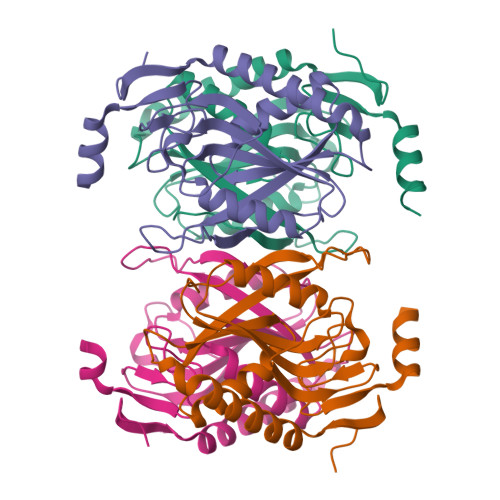The role of the C-terminal region on the oligomeric state and enzymatic activity of Trypanosoma cruzi hypoxanthine phosphoribosyl transferase.
Valsecchi, W.M., Cousido-Siah, A., Defelipe, L.A., Mitschler, A., Podjarny, A., Santos, J., Delfino, J.M.(2016) Biochim Biophys Acta 1864: 655-666
- PubMed: 26969784
- DOI: https://doi.org/10.1016/j.bbapap.2016.03.005
- Primary Citation of Related Structures:
5EUC - PubMed Abstract:
Hypoxanthine phosphoribosyl transferase from Trypanosoma cruzi (TcHPRT) is a critical enzyme for the survival of the parasite. This work demonstrates that the full-length form in solution adopts a stable and enzymatically active tetrameric form, exhibiting large inter-subunit surfaces. Although this protein irreversibly aggregates during unfolding, oligomerization is reversible and can be modulated by low concentrations of urea. When the C-terminal region, which is predicted as a disordered stretch, is excised by proteolysis, TcHPRT adopts a dimeric state, suggesting that the C-terminal region acts as a main guide for the quaternary arrangement. These results are in agreement with X-ray crystallographic data presented in this work. On the other hand, the C-terminal region exhibits a modulatory role on the enzyme, as attested by the enhanced activity observed for the dimeric form. Bisphosphonates act as substrate-mimetics, uncovering long-range communications among the active sites. All in all, this work contributes to establish new ways applicable to the design of novel inhibitors that could eventually result in new drugs against parasitic diseases.
Organizational Affiliation:
Instituto de Química y Fisicoquímica Biológicas, Universidad de Buenos Aires, Junín 956, C1113AAD Buenos Aires, Argentina.


















